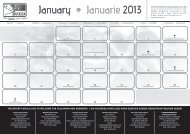Breed Standards - Sussex Cattle Breeders Society
Breed Standards - Sussex Cattle Breeders Society
Breed Standards - Sussex Cattle Breeders Society
You also want an ePaper? Increase the reach of your titles
YUMPU automatically turns print PDFs into web optimized ePapers that Google loves.
selection, although management skill is<br />
a prerequisite and a good farming<br />
contributory factor. With efficient<br />
selection we mean the ability accurately<br />
to judge the value of an animal as well<br />
as good judgement on the relative<br />
importance of the various traits for<br />
which are selected. In practice,<br />
selection progress will be determined<br />
by the following factors (over which we<br />
have no control):<br />
• The number of traits for which are<br />
selected, limit this to a minimum.<br />
One wonders often, for example,<br />
whether it is worthwhile to divide a<br />
trait such as conformation into head<br />
and neck, forequarters, middle piece<br />
and hindquarters. In practice, the<br />
points awarded are so often<br />
determined by the size of the animal<br />
that it would perhaps be better only to<br />
point a “general appearance”. Size<br />
and body size can rather be<br />
described in terms of objective<br />
measuring.<br />
• The proportion selected. This<br />
determines the superiority of the<br />
selected animals and is therefore<br />
extremely important. In practice it<br />
will depend on reproduction rate and<br />
replacement needs. The latter, in<br />
turn is largely determined by the<br />
generation interval, which we will<br />
discuss later.<br />
• The accurate elevation of animals.<br />
This is one of the most important<br />
aspects of selection. The accuracy of<br />
selection, firstly, directly determines<br />
the response obtained by selection.<br />
Secondly , the figures so obtained are<br />
priceless value to determine breeding<br />
policy. Many futile arguments take<br />
place about breeding policy simply<br />
because the data on which<br />
arguments can be based, are not<br />
19<br />
available. Measuring the<br />
bookkeeping is imperative if one<br />
strives for maximum breeding<br />
progress. Without it, it is not even<br />
possible to determine the extent and<br />
nature of the progress that is being<br />
made.<br />
Population Size<br />
After the objective has been set and<br />
decisions on accurate measuring<br />
techniques have been taken, the<br />
selection progress will further depend<br />
on the effective size of the breeding<br />
unit. Population size influences the<br />
selection progress in a dual way: the<br />
possibility of achieving favourable gene<br />
combinations are better in a large<br />
population, and risk of in-breeding<br />
smaller. The gene pool of any member<br />
of individuals found in such a species<br />
represents but a fraction of the<br />
potentially possible gene combinations.<br />
The larger the population is, therefore<br />
the better are the chances of getting<br />
individuals with favourable gene<br />
combinations. It has, in fact, been<br />
found in selection experiments with<br />
vinegar flies, that a low selection<br />
pressure in a large population brings<br />
about more progress than a high<br />
selection pressure in a small<br />
population. It is also noteworthy that<br />
the top studs in any ramification of<br />
animal breeding are always of an<br />
above average size. It is sometimes<br />
said that apart from the<br />
knowledgeableness a stud breeder also<br />
needs a bit of “luck” to get to the top. In<br />
my view this luck element is strongly<br />
connected with stud size. Provided<br />
other factors are even, the large stud<br />
will be “luckier” than the small one.




